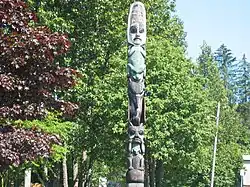The Tlingit clans of Southeast Alaska, in the United States, are one of the Indigenous cultures within Alaska. The Tlingit people also live in the Northwest Interior of British Columbia, Canada, and in the southern Yukon Territory. There are two main Tlingit lineages or moieties within Alaska, which are subdivided into a number of clans and houses.
Tlingit moieties

The Tlingit people of Southeast Alaska have multiple moieties (otherwise known as descent groups) in their society, each of which is divided into a number of clans. Each clan has its own history, songs, and totems, and each forms a social network of extended families which functions as a political unit in Tlingit society.
The moieties of the Tlingit society are the Raven (Yéil) and Eagle, Wolf, killerwhale, Frog, Thunderbird and hummingbird and butterfly. The sumilarity to moiety names are because its primary crests differ between the north and the south regions of Tlingit territory, probably due to influence from the neighboring tribes of Haida, Tsimshian and Nisga'a. Each moiety is further subdivided into clans, and each clan is subdivided into houses.
Clan names, crests and political structure
The Tlingit clans have names whose meaning typically reflects the foundation story of the clan. The clans are usually referred to in English by the name of their primary crest, such as Deisheetaan being called "Beaver Clan". This is not accurate since some crests may be held by multiple clans. Clans of opposite moieties occasionally claim the same crest, but such irregular ownership is usually due to a debt owed by some other clan; until the debt is paid, the clan holding the debt claims the crest of the clan which owes the debt, as a means of shaming it.
Clan allegiance is governed through a matrilineal system; children are born to the mother's clan and gain their status within her family, including what was traditionally hereditary leadership positions. The parents are required to be from differing clans and be opposite moieties; the children are born from the father, but he has a lesser role in their rearing than does the mother's brothers.
Not all clans listed below are extant; some have been absorbed into other clans; others have died out due to the lack of female descendants, and a few have been lost to history. Not all the clans are independent, since clans formed in a long and fluid process. For instance, the Kak'weidí descend from the Deisheetaan. Some members claim that they are a "house" within the Deisheetaan clan; others claim that they are a small but fully independent clan.
List of clans
In the list below the Tlingit name of the clan is given with its primary crest in parentheses, followed by the various kwáan (region or village) in which they are found. Known houses are listed beneath each clan.
Clans of the Raven moiety (Yéil naa)
- Gaanax.ádi — Galyáx, Xunaa, T'aaku, Aak'w, S'awdáan, Takjik'aan, Taant'a
- Táakw.aaneidí
- L'uknax.ádi (Coho salmon)
- Gaanaxteidee (hibernation frog/strong man/wood worm)
- T'éex'.ádi
- Ishkeetaan/Ishkahítaan (Ganaxteidee) (Hibernation Frog) same as Ganaxteidee (di)
- X'at'ka.aayí
- Koosk'eidí/Xaas híttaan
- X'alchaneidí
- Kiks.ádi (Frog/Herring, Rock)
- Teeyhíttaan
- Teeyineidí
- Deisheetaan (BEAVER also use of Dragonfly) —
- Aanx'aakíttaan/Aanx'aak híttaan
- L'eeneidí (Dog Salmon)
- T'akdeintaan (Sea Pigeon)
- L'ukwaax.ádi
- Noowshaka.aayí
- Kwáashk'ikwáan/Kwáashk' Kwáan
- Weix'hineidí
- Yéeskaneidí
- L'ookwhineidí
- Kuyeidí
- Téel' híttaan
- Sakwteeneidí/Sukwteeneidí
- Kijookw híttaan/Gijookw híttaan
- Taneidí
- Kookw híttaan
- Kayaa.ádi
- Tukwyeidí/Tukwweidí
- Kaasx'agweidí
- Taalkweidí
- Kuyéik'.ádi
- HeHL -non Tlinget Indigenous Peoples(Raven Moieties- Bear/Badger/Wolf/Sea Monster)
Clans of the Eagle/Wolf moiety (Ch'aak'/Gooch naa)
- Kaagwaantaan (Wolf)
- Yanyeidí
- Lkweidi
- Teikweidí (Brown Bear)
- Dagisdinaa
- Jishkweidí
- Dakl'aweidí -(House/Killer Whale Clan/Wolf Clan)
- Shangukeidí - (Thunderbird)
- Wooshkeetaan - (Shark)
- Chookaneidí - (Glacier Bear)
- Kadakw.ádi
- Tsaateeneidí
- S'eet'kweidí
- Kookhittaan - (Bear)
- Kóok Hít | Box House
- Tsaagweidí - (Killer Whale)
- Nees.ídi
- Was'ineidí - (Auklet) BEAR Kéex' Kwáan
- Tax' Hít | Teir/Platform/Bench House
- Naasteidí
- Kayaashkeiditaan
- Naanyaa.aayí (House/Killer Whale Clan/Wolf)
- Sik'nax.ádi
- Xook'eidí
- Kaax'oos.hittaan
- Neix.ádi (Eagle/Beaver/Halibut)
See also
References
- Emmons, George Thornton (1991). The Tlingit Indians. Volume 70 in Anthropological Papers of the American Museum of Natural History. Edited with additions by Frederica De Laguna. New York: American Museum of Natural History. ISBN 0-295-97008-1.
- Hope III, Andrew (2008). Traditional Tlingit Country – Map and Tribal List. Juneau, Alaska: Alaska Native Knowledge Network.